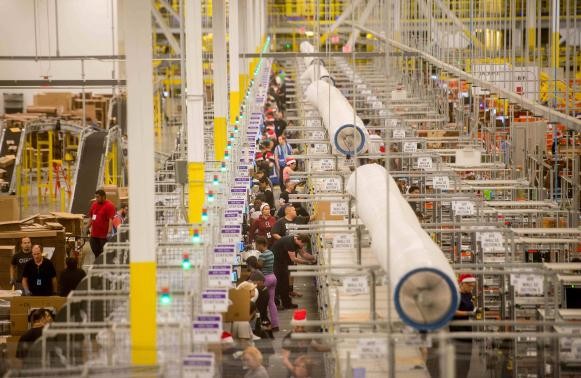Following the shopping spree on Thanksgiving, 15,000 Amazon robots have been deployed to help with picking, packing and shipping items on Cyber Monday, USA Today reported.
Amazon bought the robotic fulfilment system of Kiva Systems in 2012 for $775 million and tested the Kiva robots that resemble flattened pet carriers on wheels in 2013. Typically, the pickers go to the items, but with the Amazon Kiva robots, the items will come to them.
For two years, Amazon has been quietly working to design the system at Kiva's offices in North Reading, Mass., and at its Sumner warehouse.
Bringing the whole seven-foot shelving unit the required item is on, these robots are part of a complex hardware and software system that makes it easier to pick and pack at warehouses where millions of items are contained.
With the Kiva software, the items needed by each packer at a packing station are determined as well as the order. The robots also receive instructions from the software throughout the warehouse and are directed to bring the shelving units with the items to the packer.
On Cyber Monday, the Amazon Kiva robots navigated the floors of 10 Amazon fulfilment centers in California, Washington, Florida, Texas and New Jersey.
While the Kiva systems are currently running only at warehouses in the United States, Amazon is looking forward to introducing the robots to a few sites in other countries in 2015 and even more widely in 2016, according to Seattle Times.
Amazon's senior vice president for worldwide operation and customer service Dave Clark said: "The Kiva drive units are about a foot tall and weigh about 350 pounds. They can lift 700 pounds."
With a steady 5-mph-speed crisscrossing the warehouse floor, the robots will bring a stream of shelving to pickers at their packing stations.
Partly because of the smaller lanes required by Kiva units to move around, Amazon can double the inventory every fulfilment center can hold, which "dramatically increases what's available locally" as it allows getting "so much more inventory into one space," Clark explained.
According to Clark, while the total size of products stored in each warehouse will grow, it is likely that the overall warehouse growth number will slow down.



























